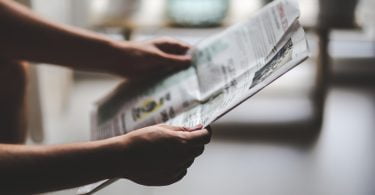The media landscape is shifting, allowing for more diverse and intense discussion on issues that affect or involve women. But are “women’s sections” really beneficial to journalism?
As more people call for change and gender equality, journalism acts as a critical platform for the discussion to take place. Some newspapers, or their online versions, use specific sections devoted to women whilst others group gender-specific articles under traditional sections such as fashion, news and entertainment.
Publications which are divided under the former method play a key role in the conversations as they address some of the most poignant issues in feminism today. This includes the meaning of modern feminism, women in politics and sexual harassment in the workplace. Reporting on news related to us women and those across the world is not only gently steering the public’s eye towards them but also opening up the floor for response, whether this comes from journalists themselves or the consumers via article sharing or commenting.
How good is Gender Mainstreaming?
The inclusion of women specific sections is an example of gender mainstreaming; a concept wherein gender issues are brought into the mainstream of society as a way to promote gender equality.
The Guardian is a publication which manages the idea of gender specific sections very well. Their online space for “women” is rich in content, all grouped under mini-topics; everything from women in leadership to video and to “talking points.”
Whilst not updated as often as their standard news equivalent, it provides a very specific space for women to be celebrated and news to be firmly on the agenda; even acting as a whistleblower on some issues which are not often seen in the western-centric press, such as the story of Nagwa, a woman’s rights activist who was detained by police because she tried to speak out about rape and abuse at the hands of Sudanese authority.
With such inhumane treatment of women still prevalent across the world, the weapon the journalist’s wield is one of spreading awareness.
A very effective way to push for change or for people to listen is via the media. If women’s issues weren’t discussed here they wouldn’t be so overtly available to inform the public.
Secondly, the weapon holds the power of expression; allowing strong and diverse female voices to permeate the often one strand comment sphere, whether this is about family life, pregnancy or beyond.
They, alongside The Telegraph, The Huffington Post, The Economist and The New York Times, are creating a divide between gender news, which is a relatively new phenomenon that reflects the ever changing way we classify news and also how the gender debate and fight for equality is gaining momentum, gaining more coverage and more interest.
75 years after Virginia Woolf’s death, women still want rooms of our own #VirginiaWoolf https://t.co/mMIqZ5p5Zf pic.twitter.com/l7GFyd0HEr
— Telegraph Women (@TeleWonderWomen) March 29, 2016
A gender bubble
But if this fair, diverse and equal conversation is held exclusive to these sections, we run the risk of placing the issues within a media bubble, driving a gender centric wedge through media.
However, we can also look at this as a beam of power; a shout from women who have been fighting for a place in journalism in the same way they fought for the vote and for the right to abortion. Now, the modern world has granted these historic cries the attention they need.
Women are underepresented
Its old news that women are underrepresented in print and radio, where a lack of diversity rings out loudly. However, there is little research into how this translates into the digital sphere, where more space for content means more chance to curate expansive “women’s sections.”
A report from the non-profit Women’s Media Centre in 2015 looked at US journalism and found that men are still the dominant players. Despite making up half the population, women only write a third of the stories; and the stories they do write were of a restricted nature. Their study, which looked at nation’s 10 most widely circulated newspapers, the national evening news broadcasts, the most-viewed Internet news sites and two international wire services, found that man were more likely to write stories about politics, criminal justice, science, sports and technology.
In print, men wrote 62 percent of all stories in 10 of the most widely circulated newspapers. Women wrote just 37 percent.
On the Internet, men wrote 58 percent of content at four online news sites. Women wrote 42 percent of the content.
So whilst the gender gap is still rather wide, we have to question whether these “Women’s sections” are dictating the narrative of what women write, and what our gender is interested in reading about.
Women are much less likely to write “hard news” and as men run the newsrooms, are these female friendly editorial sections just driving women further away from the political and technological aspects?
Of course, this study only took place in the US, and we cannot force women into or assume they desire to write within these male dominated fields.
Regardless, we must be societally conscious of how we are viewing women in the media, in the same way we have been in other walks of life.
This brings us full circle, to a standpoint of observation and critique of women and issues that affect them, which are discussed in the public sphere through these women sections.
The role of women’s sections
The role of these sections seems to be to shine light, to share media voices, analyse problems and share news from all corners of the world.
What is unclear is whether these sections are necessary or whether articles about women are better placed among the generic news sections, to dissolve and integrate within the mainframe.
Whilst The Daily Mail objectifies women, with articles devoted to celebrities bikini bodies, their “femail” section addresses body image issues, such as Photoshop in the media or self-confidence, and overall is a reverse on the feminine conversation made in their generic news.
This isn’t necessarily a good thing; as it begs the question of why this rhetoric isn’t consistent.
As mentioned, The Guardian has an impressive women’s section, yet articles such as this, whilst a woman’s own opinion, is critical and damaging to the modern, free woman.
More research needs to be conducted to discover whether sites like The Independent, which doesn’t have a women’s section, write less articles in this subject field and devote less attention to gender specific news.
I believe it’s crucial to keep celebrating women, to promote “alternative” walks in life (such as Vice’s “Why unmarried women are more powerful than you think.”) and to give a voice to the often unheard in developing countries; in a continually technologically advanced world with a thirst for gender steered conversation.
What do you think? What role do women’s sections have in journalism and the discussion of gender issues? Have your say in the comments section below.










